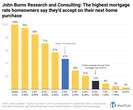The Industrial Revolution gave us the assembly line, and with it, a simplified concept of productivity: more is more. Assuming quality remained the same, generating a greater output equaled higher productivity. For today’s knowledge workers, the nature of the output has changed. The goal for many workers isn’t necessarily to do more work, but perhaps better, more innovative, more impactful work.
Too often, professionals fall victim to chasing an outdated notion of productivity and the result is burnout—a psychological syndrome characterized by emotional exhaustion, cynicism, and less personal accomplishment. A recent survey by Gartner found that four in ten Americans report suffering from burnout.
Perhaps in response to the burnout epidemic, many workplaces are shifting to a new concept of productivity. “Slow productivity,” a term coined by author Cal Newport, suggests that doing fewer things of higher quality leads to more genuine productivity.
As an entrepreneur in the business of eliminating busywork for nearly two decades, I wholeheartedly agree with Newport’s approach. And now, automation may be able to help us unlock slow productivity. While some may believe that new automated tools should be used to just produce more, I believe automation should be used to help us produce better work. Here’s why busywork and “pseudo-productivity” are the antithesis of meaningful achievement, and how we embrace slow productivity in our personal and professional lives.
The hidden cost of busyness
In our daily work lives, most of us are drowning in busywork. For all technology has given us, facilitating connection, communication, and creativity, it’s introduced a bottomless pool of potential distractions. Momentary distractions, like quick email glances and social media scrolls, combined with tedious manual tasks that lack engagement, eventually derail us from deeper objectives. It’s easy to lose sight of what really gives us meaning at work and to focus (or waste) our energy on ticking another item off our to-do list.
Newport calls this working style pseudo-productivity: the tendency to gravitate away from deeper efforts to shallower, more concrete tasks that can be easily accomplished; in other words, the low-hanging fruit. This approach creates a more chaotic energy that exhausts our fuel and leaves us running on fumes.
The benefits of slow productivity
The antidote, according to Newport, is slow productivity, which entails doing fewer things, working at a natural pace, and obsessing over quality. Slow productivity means reducing the sheer volume of work, not necessarily hours at the office.
So what are those “few things” you should focus on? In my book, I frame the question as: What is my vision of meaningful work? To begin, take 15 minutes to describe your personal vision of work that matters to you and your career. Grab a pen (or pull up your favorite automated note-taking app) and consider:
- Which tasks bring you the most joy?
- What would you like to save your brain to do more of?
- Which efforts deliver the most impact?
Include as many details as possible in sketching out your vision. Once you identify your meaningful work, your next challenge is vigorously defending time for it. Turn off notifications, block out other distractions, and, as Newport recommends, obsess over the quality.
So, how can we deal with the tasks that fill our days but drain our energy?
How to achieve slow productivity
When I first launched my company, I jumped from task to task, handling the most urgent items as they rolled in. It felt a lot like playing whack-a-mole. In those days, I never could have imagined running my business and writing a book, something that had been a goal of mine for as long as I can remember. But that’s what I did recently, and I never could have done it without a seismic change in my approach to tackling my to-do list. In particular, I had to rigorously automate my busywork.
Automating your busywork requires carefully mapping out your typical day—every step of every task, including each contingency and dependency. In the process, you’ll realize that most tasks and projects involve multiple steps that lead to a certain result—or as I call them, workflows. You’ll be able to more accurately plan your day. But more importantly for this exercise, you can identify any flaws in your processes as well as the tasks that can be fully or partially automated.
For example, let’s say you’re a journalist mapping out your process of writing a profile of someone. You map out the steps: email the subject to schedule the interview, conduct the interview, transcribe notes, outline the story, etc. Already, two of those steps—scheduling the interview and transcribing your notes—are ripe for automation. There are great AI-powered tools for each. Suddenly, two items are removed from your to-do list. You can dedicate more time to the meaningful aspect of your work: crafting a compelling portrait of your subject. You have more mental energy to obsess over the quality.
The more you automate, the more time you can dedicate to tasks that give you a sense of purpose, and the more your momentum and motivation build. It becomes a virtuous cycle. That’s the key to making headway on your meaningful work, or as Newport refers to it, achieving “genuine productivity.”










No comments